We have arrived in Pucon in the north of southern Chile close to the border with Argentina (actually all of Chile is close to the border with Argentina but this is but a rocket propelled grenade away). Pucon has arrived on the global map as a Mecca for adventure sports and has been described as the ‘Queenstown of Chile’, an adrenaline junky’s paradise – that’s us, obviously. If it can be hiked, biked, ridden, climbed or jumped, it can be done in Pucon.
 The setting is fantastic, sitting just below the smouldering summit of Volcan Villarrica, surrounded by wooded hills and steep mountains and on the northern shore of Largo Villarrica. The area is very green, almost lush, and reminds me of the countryside in northern France with giant poplars and vibrant splashes of colourful flowers. The Mapuche Indians still own large areas of the land and are very much in evidence in the local population where the european-indian bloodlines are intermingled.
The setting is fantastic, sitting just below the smouldering summit of Volcan Villarrica, surrounded by wooded hills and steep mountains and on the northern shore of Largo Villarrica. The area is very green, almost lush, and reminds me of the countryside in northern France with giant poplars and vibrant splashes of colourful flowers. The Mapuche Indians still own large areas of the land and are very much in evidence in the local population where the european-indian bloodlines are intermingled.
 Top of our agenda here is to climb Volcan Villarrica (2847 metres/9,250 feet), a perfect cone volcano that is still active and smoking. It is part of the so-called ‘Pacific Ring of Fire’ and, along with nearby Volcan Llaima, it is the most active volcano in Chile having managed 10 eruptions during the 20th Century. The last time it exploded was in 1984/85 so it is due for another any time now. There is a local volcano watching station that is supposed to be able to give fair warning of unusual activity within the mountain and, everyday at noon, they sound the get-out-of-here-quick siren just to make sure it works.
Top of our agenda here is to climb Volcan Villarrica (2847 metres/9,250 feet), a perfect cone volcano that is still active and smoking. It is part of the so-called ‘Pacific Ring of Fire’ and, along with nearby Volcan Llaima, it is the most active volcano in Chile having managed 10 eruptions during the 20th Century. The last time it exploded was in 1984/85 so it is due for another any time now. There is a local volcano watching station that is supposed to be able to give fair warning of unusual activity within the mountain and, everyday at noon, they sound the get-out-of-here-quick siren just to make sure it works.
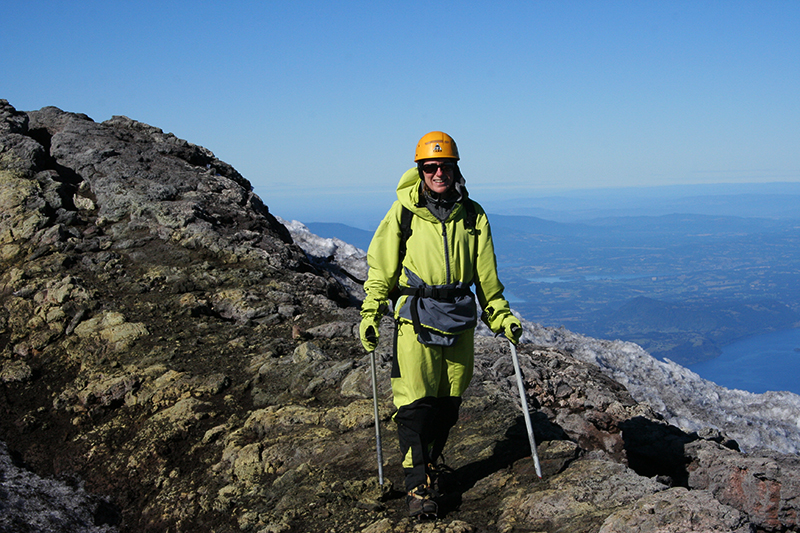 We decided to make the ascent with a tour company that started at 4.00am so that we could make the most of the snow and ice before it softened up and to make sure we got to the top before anyone else (there’s nothing more irritating than having a crowd of people around a spectacular view). They gave us some unpleasant coloured overalls that made us look like corporation effluent operatives, an ice axe, a helmet (in case Debbie decided to take me out during the climb), and boots. The latter were a big mistake being stiff climbing boots size 14 that rubbed my feet raw but which took my mind off the difficulty of the ascent.
We decided to make the ascent with a tour company that started at 4.00am so that we could make the most of the snow and ice before it softened up and to make sure we got to the top before anyone else (there’s nothing more irritating than having a crowd of people around a spectacular view). They gave us some unpleasant coloured overalls that made us look like corporation effluent operatives, an ice axe, a helmet (in case Debbie decided to take me out during the climb), and boots. The latter were a big mistake being stiff climbing boots size 14 that rubbed my feet raw but which took my mind off the difficulty of the ascent.
 In fact, as we set off in pitch darkness, the first hour was the worst because it was impossible to see the black volcanic trail and the enormous boots I was wearing made climbing up narrow footholds annoyingly difficult. Even more annoying was that the trail was underneath a chair lift that we could have ridden had we began at a more sociable hour and by the time we reached the end of the lift at 1,400m I was already sweating uncomfortably. Fortunately, we took a break at this point to put on crampons and sort ourselves out before starting on the ice so by the time we began again I was cold.
In fact, as we set off in pitch darkness, the first hour was the worst because it was impossible to see the black volcanic trail and the enormous boots I was wearing made climbing up narrow footholds annoyingly difficult. Even more annoying was that the trail was underneath a chair lift that we could have ridden had we began at a more sociable hour and by the time we reached the end of the lift at 1,400m I was already sweating uncomfortably. Fortunately, we took a break at this point to put on crampons and sort ourselves out before starting on the ice so by the time we began again I was cold.
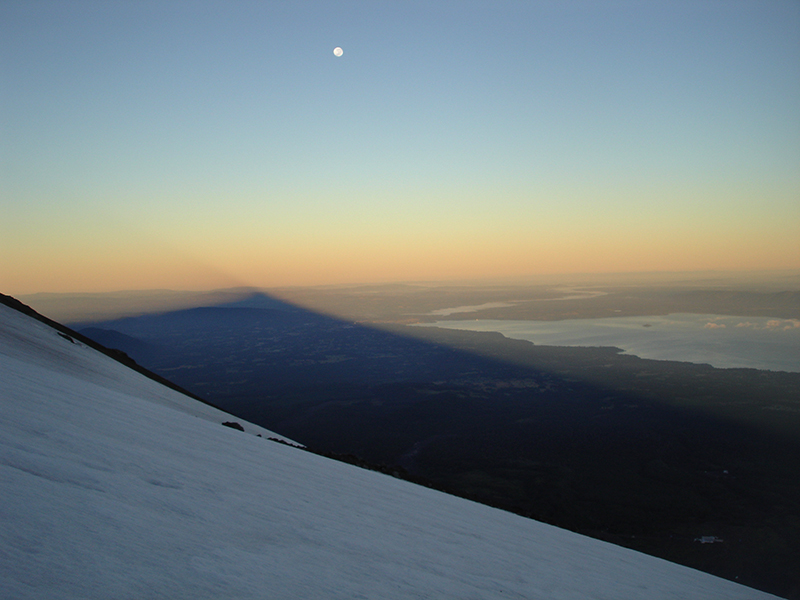 Thereafter, once out on the ice, although it was steep in places, it was easy going. The snow and ice had smoothed out the mountainside so it was simply a case of trudging on, taking small steps and stopping for the occasional photograph. The most difficult part was trying to keep the guide from stopping too often and for too long because we did not need the breaks and we just got cold.
As the sun came up, the land below was slowly revealed into light and the shadow of the billowing volcano was thrown for miles across the hills. It was stunning. A perfect morning for climbing without a cloud in the sky and not too much wind gave us the most spectacular views for over 100 miles in every direction. Once again, we felt we were on top of the world, experiencing a wonderful feeling of freedom, of space and wellbeing. It is a sensation that can only be experienced in the cold, clear air of the mountains and it is worth every ounce of energy it takes to get out of bed and struggle up here.
Thereafter, once out on the ice, although it was steep in places, it was easy going. The snow and ice had smoothed out the mountainside so it was simply a case of trudging on, taking small steps and stopping for the occasional photograph. The most difficult part was trying to keep the guide from stopping too often and for too long because we did not need the breaks and we just got cold.
As the sun came up, the land below was slowly revealed into light and the shadow of the billowing volcano was thrown for miles across the hills. It was stunning. A perfect morning for climbing without a cloud in the sky and not too much wind gave us the most spectacular views for over 100 miles in every direction. Once again, we felt we were on top of the world, experiencing a wonderful feeling of freedom, of space and wellbeing. It is a sensation that can only be experienced in the cold, clear air of the mountains and it is worth every ounce of energy it takes to get out of bed and struggle up here.
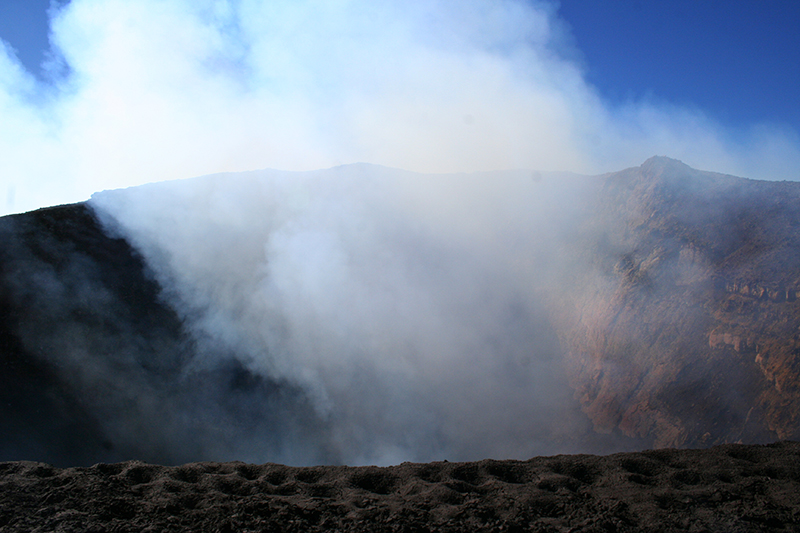 After four and a half hours the distinctive smell of sulphur hit us as we breasted the summit. My lungs were beginning to feel the effect of the altitude and I was taking deep rhythmical breaths for the last half hour so as the wind blew a thick cloud of sulphur about me I thought I was going to drown. It stripped my throat and burnt my lungs and was a most unpleasant welcome to the top of the volcano. Whenever we crept close to the edge of the crater, the wind would ensure that we had a good dose of sulphur; I could feel it and taste it for 2 days afterwards.
After four and a half hours the distinctive smell of sulphur hit us as we breasted the summit. My lungs were beginning to feel the effect of the altitude and I was taking deep rhythmical breaths for the last half hour so as the wind blew a thick cloud of sulphur about me I thought I was going to drown. It stripped my throat and burnt my lungs and was a most unpleasant welcome to the top of the volcano. Whenever we crept close to the edge of the crater, the wind would ensure that we had a good dose of sulphur; I could feel it and taste it for 2 days afterwards.
 We spent an hour enjoying the views, taking photos, having something to eat and, periodically, being suffocated. It was not possible to see any distance into the crater because of the suphur smoke so we did not see any bubbling lava (assuming there was any) despite the fact that the crater was 1,500m (nearly a mile) in diameter. We spent our precious time as far upwind as possible!
We spent an hour enjoying the views, taking photos, having something to eat and, periodically, being suffocated. It was not possible to see any distance into the crater because of the suphur smoke so we did not see any bubbling lava (assuming there was any) despite the fact that the crater was 1,500m (nearly a mile) in diameter. We spent our precious time as far upwind as possible!
 If the ascent was not too taxing, getting down was a breeze. We took off our crampons, strapped around our bottoms a large, thick piece of canvass and slid down the mountain. There were a number of ‘runs’ that previous backsides had cut into the ice to smooth our descent and, using the ice axe as a brake, we bumped and shot down the slope. At this time there were loads of others coming up; long lines of ducks winding across in front of us trudging upwards. So much for health and safety, how no one got wiped out is a mystery only God can answer.
If the ascent was not too taxing, getting down was a breeze. We took off our crampons, strapped around our bottoms a large, thick piece of canvass and slid down the mountain. There were a number of ‘runs’ that previous backsides had cut into the ice to smooth our descent and, using the ice axe as a brake, we bumped and shot down the slope. At this time there were loads of others coming up; long lines of ducks winding across in front of us trudging upwards. So much for health and safety, how no one got wiped out is a mystery only God can answer.
Unfortunately, the fun stopped at the top of the chair lift where the snow and ice finished leaving a final trek downhill that saw me hopping painfully on raw feet. I had also bruised my coccyx sliding downhill when, slightly out of control, I hit a bump harder than I would have wished. Debbie, of course, was skipping along like a new born lamb and had to be physically restrained from going back uphill again!
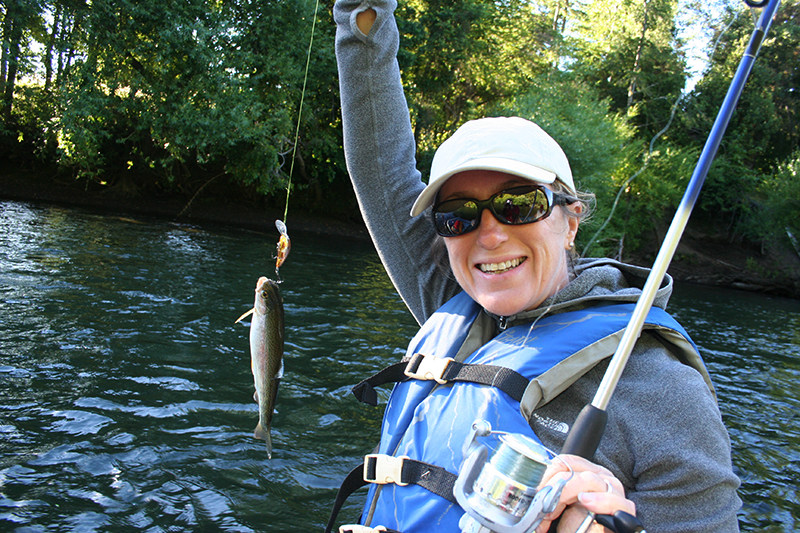 After the exertions of the climb, we moved on to the next adrenaline adventure: Fishing. I fancied another go after the great time I had in Barriloche in Argentina and Debbie wanted to come along to enjoy the scenery in the mountain river, Rio Trancura. Being (after one go) an expert fly fisherman I armed myself with a suitable fly rod complete with a fancy wet fly. Debbie, who was a river-fishing virgin, had a miserable spinner. It will surprise no one that Debbie caught precisely twice as many fish as I did and, had she not generously declined to land several more, I would have had to walk home in disgrace.
After the exertions of the climb, we moved on to the next adrenaline adventure: Fishing. I fancied another go after the great time I had in Barriloche in Argentina and Debbie wanted to come along to enjoy the scenery in the mountain river, Rio Trancura. Being (after one go) an expert fly fisherman I armed myself with a suitable fly rod complete with a fancy wet fly. Debbie, who was a river-fishing virgin, had a miserable spinner. It will surprise no one that Debbie caught precisely twice as many fish as I did and, had she not generously declined to land several more, I would have had to walk home in disgrace.
The river itself was narrow but had a clear, fast flowing stream that raced over rocky shallows and rested in deep tree lined pools where the banks ran into golden meadows. The water glinted and glistened in the late afternoon sunlight as a kingfisher popped up to steal our prey. There is something very relaxing about floating downstream in a little boat, drinking beer, enjoying nature and talking about nothing in particular. It was a great way to recover from a trek and prepare for horses.
 Of course, it is not possible for Debbie to pass up the chance to enjoy a ride across the countryside, so we turned up at an out of the way little farm called Ruka Rayen that had been recommended by the hostal for those who ‘knew how to ride’. Luckily, we were the only two customers they had so we were given a pair of fit looking nags and taken out into the forested hills by a German girl called Nadia who was spending 6 months in Chile to learn Spanish. Once we had walked for an hour and got to the base of the hills we were off, trotting up the steep bits, cantering along the ledges at the edge of the woods by the side of the hills. The horses did not need much encouragement to get going being only too willing to float over the winding trail that steadily rose to the top of the hills overlooking a wide valley.
Of course, it is not possible for Debbie to pass up the chance to enjoy a ride across the countryside, so we turned up at an out of the way little farm called Ruka Rayen that had been recommended by the hostal for those who ‘knew how to ride’. Luckily, we were the only two customers they had so we were given a pair of fit looking nags and taken out into the forested hills by a German girl called Nadia who was spending 6 months in Chile to learn Spanish. Once we had walked for an hour and got to the base of the hills we were off, trotting up the steep bits, cantering along the ledges at the edge of the woods by the side of the hills. The horses did not need much encouragement to get going being only too willing to float over the winding trail that steadily rose to the top of the hills overlooking a wide valley.
 At this point we stopped for lunch at a hillside farm that consisted of a couple of small paddocks, a one room hut with more gaps in the walls and roof than cover, a ramshackle barn that had definitely seen better days and four very hungry dogs that we had to tie up to stop them stealing our luncheon. The farmer, a strapping chap who arrived during lunch with two enormous bulls yoked together, had lived there all his life and was now the sole occupant after his parents died two years ago. On balance it did not seem the sort of life or lifestyle that Debbie and I would enjoy.
At this point we stopped for lunch at a hillside farm that consisted of a couple of small paddocks, a one room hut with more gaps in the walls and roof than cover, a ramshackle barn that had definitely seen better days and four very hungry dogs that we had to tie up to stop them stealing our luncheon. The farmer, a strapping chap who arrived during lunch with two enormous bulls yoked together, had lived there all his life and was now the sole occupant after his parents died two years ago. On balance it did not seem the sort of life or lifestyle that Debbie and I would enjoy.
Unfortunately, my coccyx which had been badly bruised slipping down the volcano was now really sore and I could hardly sit in the saddle because the back of it was hard against my delicate posterior. So the girls raced on whilst I tried to find a half-standing position in the stirrups that did not hurt too much and I found myself leaning forwards with my head alongside that of my horse. The horse was not impressed by this nor by the fact that his mates had raced away and were having fun whilst he was stuck with a plonker who could not sit down. He whinnied, complaining loudly whenever the girls generously stopped to wait for me. When we got back to the farm where we started, Debbie gently massaged my delicate bottom in a way that made sustaining the injury almost worthwhile!
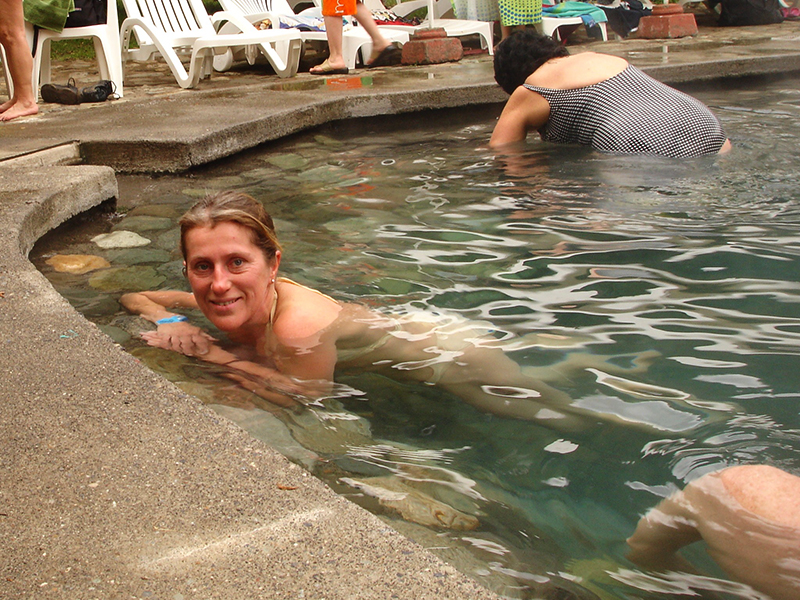 To provide further therapy, we went off to the natural hot springs at nearby Termas Huife. The hot-spring waters certainly helped. Coming out of the ground at 38c into a manmade pool, it felt at first like getting into a nice hot bath but after 10 or 15 minutes it got too hot and we began sweating. The idea was to go to the next pool that was full of water direct from the river and cool off. Having put one foot into the cold water I decided I was cool enough thank you but Debbie, made of sterner stuff, swam a few lengths before rushing back to the hot pool.
To provide further therapy, we went off to the natural hot springs at nearby Termas Huife. The hot-spring waters certainly helped. Coming out of the ground at 38c into a manmade pool, it felt at first like getting into a nice hot bath but after 10 or 15 minutes it got too hot and we began sweating. The idea was to go to the next pool that was full of water direct from the river and cool off. Having put one foot into the cold water I decided I was cool enough thank you but Debbie, made of sterner stuff, swam a few lengths before rushing back to the hot pool.
Eventually, when we were thoroughly boiled, we had a couple of cold beers and returned to base.
We also investigated the white water rafting. The higher rivers around Pucon are classed as category IV (apparently V is like going over Niagara Falls in a barrel) and I had managed to persuade Debbie to have a go again after our very very cold experience in New Zealand three years ago. As the weather was due to be poor what better time to go rafting? The chap in the shop explained it all, how the waters from the glaciers rushed down between rocks and over waterfalls and how we would do well to remain in the boat. He then showed us pictures that included dragging the four man raft around the most impenetrable rocks and then jumping into the river and swimming after it. I could sense my wife’s body language stiffen as her jaw set hard.
‘If I get cold doing this, I will never speak to you again!’
I weighed up the pros and cons of this interesting proposal and decided that, on balance and taking all possibilities into careful account, we should back out gracefully. So we hired a car instead.
We went on a little tour of the area up to 50 miles south of Pucon, taking in a number of small towns and villages untouched by the hectic tourism where we were staying. It was like a drive in the Lake District with fine views across lakes and hills and would have taken in the surrounding volcanoes had the weather allowed us to view them. The beaches around the lake shores were black volcanic pebble that led to thick grass, a deep green, strong and vibrant. The lake waters were all beautifully clear and empty of people and boats. We were about an hour from Pucon but could have been ten times that judging by the quiet solitude of the hills.
Our last day the weather was even worse than before: rain, wind and cold. Apparently, we are unlucky with the weather (again!). We have booked the night bus for the twelve hour trip up to Valparaiso on the coast west of Santiago. We are hoping for warm weather again and a chance to put on shorts and shades.



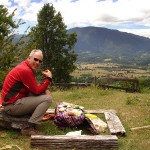

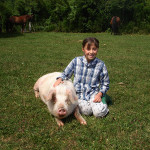
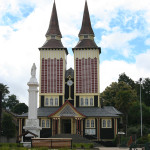

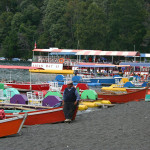
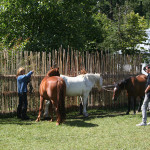
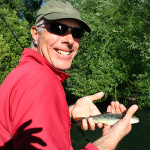


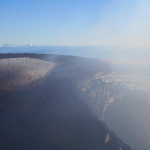

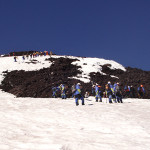

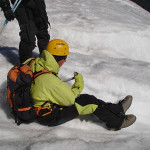



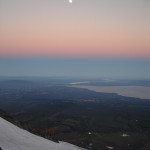
No comments yet.